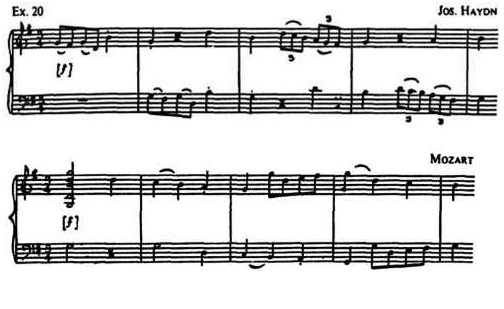
Literate musical art: the area of scores, highly trained performers, teachers, and composers: all of the contributors and practitioners of “advanced musical literacy”: devoted to continuing European musical literature, developed over roughly 800 years; and the American continuation and development of musical literacy in “classical” music and jazz. Duke Ellington, a musician of rare talent and accomplishment, was once an important figure; one wonders how many Americans now have any notion who he was, and what he represented in his time. Literate musical art is now heavily marginalized – although this cultural area prospered, if modestly, alongside the dominant (typically non-literate) commercial music until very recently.
This is a tribute to this vanishing musical area. In particular, to Mozart, one of the greatest exponents of this cultural tradition. Mozart’s synthesis of lyricism and contrapuntal skill attracted profound admiration for generations, and is a central theme in Einstein’s text, translated below (section 1 of 5).
Source: Mozart. His character and works, by Alfred Einstein. (Translated from „Mozart und der Kontrapunkt“ in Mozart. Sein Charakter, sein Werk. Alfred Einstein. Zürich, Stuttgart 31953, S. 174-189. Lizenz: verwaist/ License: abandoned.)
___________________________________________________________________________________
“Mozart and counterpoint“ (excerpt 1)
Alfred Einstein
Mozart was born in a musical period described as “galant”, which had completed a certain break with the past. The basis of this break referred back, however, more than 150 years. In this, a group of aestheticians and musicians associated with the so-named Florentine Camerata declared war on counterpoint; this was done in favor of making words more understandable, and inaugurated “monodic” vocal and instrumental music. Composers began writing cantatas and operas, solo and trio sonatas. These reflected melodic leadership growing from (a distinct) harmonic awareness. The principle of polyphony changed over to the concertato principle.
Yet polyphony, counterpoint, the combination of independent voices, is an eternal principle in music. Composers did not give up the “fugal” manner. Instead, one had available two distinct compositional types. Only later, toward the end of the 17th century, was a musician born who melded and unified harmonic and polyphonic thought; who by means of complete harmonic understanding led polyphony to its summit: J.S. Bach.
In a sense, however, Bach was a posthumous musician. All around him, in Germany, Italy, and France, the “galant” style had overtaken polyphony, the stricter contrapuntal forms. Such polyphonic forms were viewed as both older and outmoded. They had an archaic air.
When a modern composer of the (galant) time wrote a mass, for example the influential Alessandro Scarlatti, he had the choice of two styles: the “galant” or the “old” types. The “old” style here refers to that of Palestrina [c. 1525-1594] – or what was held in the 17th and 18th centuries for this style. So a composer could write completely in one style or the other. He could also choose to mix the lighter and stricter forms. Further, a composer not writing for the church might never use the stricter style. An example here is Gluck. We do not have a fugue from him, either vocal or instrumental. Even more, it seems “free imitation” hardly existed for Gluck as a compositional technique. Yet he was not wrong, from his standpoint, to no longer find use for the stricter style.
For what Gluck was offered in his time, by his environment, was no longer a genuine, living polyphony. It was an artifact. This polyphony was stiff, frozen; a product of instructional guides. The most famous of these guides was itself a product of posthumous thought. This was the “Gradus ad Parnassum”, from 1725. Conceived in dialog (!) form, the book was written by Johann Joseph Fux, court music director for the [Holy Roman] emperor.
About 10 years later, 1735 or 1736, Pergolesi wrote his “Stabat Mater” (“Duetto spirituale”), in the midst of declining health. The work enjoyed immense fame and exposure in the 18th century. It also reveals in pure form the division between styles: with the text by Jacopono da Todi divided into 12 arias and duets, pure opera (or even buffo) style is mixed with spare, conventional polyphony. Thus “Fac, ut ardeat” is in stricter style; as is the concluding “Amen” section of “Quando corpus morietur”.
This stylistic mixture of the “galant” and “learned” predominated for the entire 18th century, especially in church music. Composers still wrote instrumental fugues of course, here and there, in Germany and Italy. Yet this was done without awareness, other than with the quiet man in Leipzig [Bach], his sons and students, of what the invention of a real fugal theme and its proper development involved.
For church music, however, a tradition developed where certain parts or sections were often composed in “fugal” or “polyphonic” style. Thus in the mass, examples are “Et vitam venture” and “Cum sancto spiritu”; or sometimes the “Patrem” or “Dona”. In a Te Deum, the techniques appear in the “In te Domine speravi”; and in the Litany the “Pignus”. The “Sicut erat in principio” from the Magnificat is a further example.
Church musicians, then, needed to be well versed in all aspects of the “stricter style”. Thus Leopold Mozart instructed his son Wolfgang accordingly. From 1767 we have record of Mozart’s (now lost) “Fugues for Clavier”. Two years before in London, Wolfgang wrote a small 4-part choral work (K.20) for the British Museum. This work can be called “polyphonic”; and this feature is the best and highest proof of the Wunderkind’s early mastery. The “Galimathias musicum” of 1766 concluded with a fugue, whose theme derived from the song “Willem van Nassau”. This piece required, significantly, energetic assistance from the father. In Mozart’s G major Cassation from the spring of 1769, we already find a minuet in which the basses follow upper strings in canon, by a one measure distance. This is an exact imitation of the minuet from Joseph Haydn’s G major Symphony (No. 23) of 1764; it is likely Mozart heard this work in Vienna:

Translation by Edward Eggleston
_______________________________________________________________________________________________
